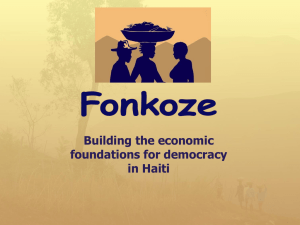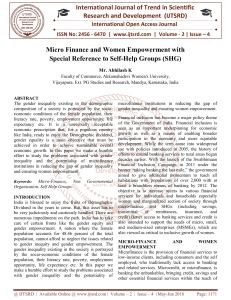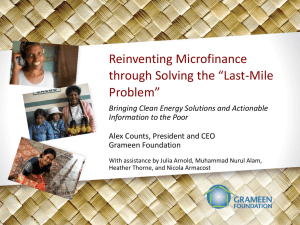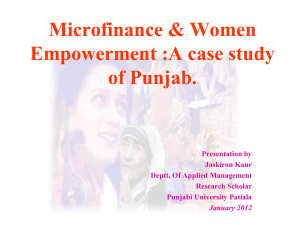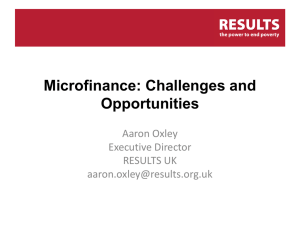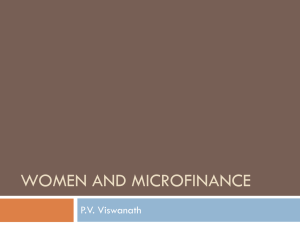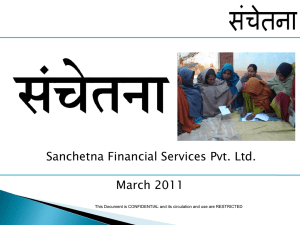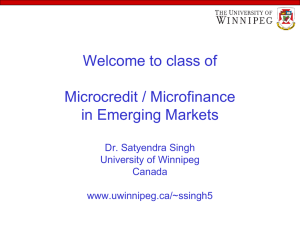JennetKem1110 - League of Women Voters of New York State
advertisement
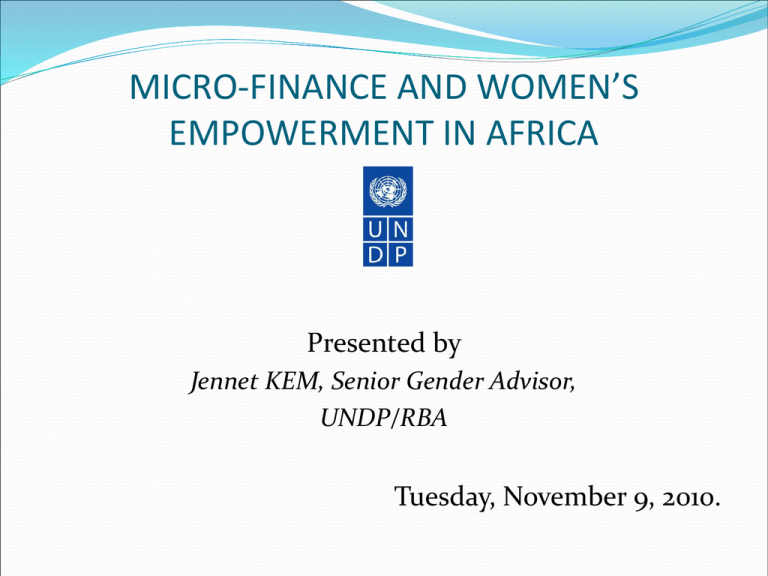
MICRO-FINANCE AND WOMEN’S EMPOWERMENT IN AFRICA Presented by Jennet KEM, Senior Gender Advisor, UNDP/RBA Tuesday, November 9, 2010. Presentation Outline This paper is presented at a Panel Discussion on MICRO- FINANCE: From Struggle for Survival to Planning for the Future organized By THE LEAGUE OF WOMEN VOTERS of New York. Here is the outline: Brief Overview of Micro-finance and Women’s Empowerment; Micro-credit and economic empowerment for women: Some Successes Challenges; Some Case-studies; Some critique-Challenges and constraints Encouraging different policy options Conclusion and Food for Thought Overview Microfinance is the provision of very small loans (micro credit) and a broader range of services (credit, savings, insurance, remittances etc.) in a cost effective and sustainable manner to very poor families. (Liberia Inclusive Finance sector); Microfinance has improved the lives of many poor, marginalised and vulnerable people around the world, especially in Africa and Asia by enabling them engage in income generating activities, education and citizens awareness programmes, etc; Where well managed and directed, microfinance has accrued enormous benefits in creating wealth, improving health, generating employment and enhancing status for the beneficiaries; However, Microfinance is not a total panacea, cannot solve all problems of women’s empowerment and has its own challenges, including exploitative interest rates, webbing poor women in chains of debts, increasing the work burden-in the absence of appropriate support system, etc; There is thus a call for more critical analysis of this empowerment mechanism, to be able to come up with better policy options and orientations. Some Successes/Benefits MF has enabled millions of poor families and communities to come out of poverty; transformed their lives and those of others. Examples abound, supported by the UN (UNDP, UNCDF, UNICEF, etc), Development agencies eg USAID, CIDA, etc; Foundations like B/M Gates, NGOs such as WfW, ActionAid, etc. Examples of successful cases have been documented in: Liberia-The Unsung heroes; DRC-ESPOIR and other groups; Nigeria-Integrated initiatives by many women’s/community groups , Cameroon-the Grassfield project, CCC, Modest/Mutual Sisters and Sisters In Solidarity, etc in Cameroon; Benin, Ethiopia, etc. Some benefits of MF include: Wealth and employment creation inBurkina Faso, Mali, Togo, Senegal, with support from the B/M Gate’s Foundation and in Liberia, Nigeria; Improved status, respect and dignity; More social and family collaboration, etc. Some Case Studies: Liberia Microfinance services provided by many actors-Banks, NGOs, Credit Unions, ROCAS (Rotating Savings and Credit Associations-susus), UNDP, UNCDF and Cordaid (NGO based in Netherlands are implementing a project called ‘Launch of an Inclusive Financial sector in Liberia Project (2005-2007); Project provides support for institutional strengthening of MFIs and provides funds for outreach; Project supports two largest MFI, viz, Local Enterprise Assistance Programme LEAP) and ARC/Liberty Finance, operating in some counties; Clients: By 2006, over 8,000 clients, over 80% being women, served; Clients started with loans as small as 10-20USD, which serviced microbusinesses, most of which have grown to larger entreprizes, worth tens of thousands of US Dollars; Clients are engaged in a variety of income generating activities including food-stuff retailing, soap making. For more, visit YouTube UNDP Microfinance Liberia at: http://www.youtube.com/watch?v=XsDOVUOWP2c Some Case Studies: DRC USAID has provided $7 million to assist survivors of (SGBV) in Eastern prov of the (DRC), for 3years, following Secr Hillary Clinton’s visit in 2009; Project is entitled “ESPOIR”, or “Ending Sexual Violence by Promoting Opportunities and Individual Rights,” includes an englobing package of services, including health, training, counselling and micro-finance; Program is implemented by an NGO-International Rescue Committee (IRC) through its network of local NGOs; Nearly 15,000 vulnerable girls and women are receiving assistance in the provinces of North and South Kivu; 45 community-based groups in the targeted provinces are receiving assistance to help individuals and families regain their livelihoods and roles within their communities; The IRC has also partnered with the NGO Women for Women International, to provide rights-based education, health and sexuality, vocational and business skills training, and income-generation assistance to SGBV survivors and other vulnerable women; Results: Beneficiaries manage businesses better, have better livelihoods, able to send children to school, etc. Some case Studies: NGO Experience: Microfinance Transforming Lives The Hunger Project’s (THP) Microfinance Programme is a training, savings and credit program that addresses a critical missing link for the end of hunger in Africa: the economic empowerment of the most important but least supported food producers on the continent - Africa's women. Implemented by the Women for Women International in Benin, Burkina Faso, Ethiopia, Ghana, Malawi, Mozambique, Senegal, Uganda; Since inception in 1999 it has grown a loan portfolio of close to US$2.2million; Provides women food farmers easy access to credit, training and teach them the importance of saving, THP enables women to engage in IGA to build capital, pay their children's school fees, construct pit latrines, pay for health care, improve lodging or build homes; THP also offers men the opportunity to participate in the Microfinance Program, following the same principles and procedures. Worth noting that THP allocates close to 90% of all loan funds to women. The programme has reached out to millions of HIV/AIDS victims, poor women farmers, including in Nigeria, poor households and men’s Organisations NB: See more on this by Women for Women International and in collaboration with a network of partners. Some Case-studies-Benin, Cameroon and Ethiopia and my personal experience Cameroon: UNDP’s Micro projects for poverty reduction, MIDENO Grassfield (grasroots) Project, funded by the African Development bank; Ethiopia: Micro finance and other forms of support improving livelihoods, enhancing food security and increasing incomes and jobs; My experience as co-founder of CCC Plc, Mutual Sisters, Modest Sisters, Sisters in Solidarity. Some Challenges Despite the enormous contribution of MF beneficiaries to their respective economies, they do face a number of challenges, including: Unrecognized efforts as most supported initiatives are too micro and often in the informal sector; Few systems in place to track and follow-up other aspects of their lives (care work, relationships in typical male-dominated preexisting conditions, protect rights to own and manage the proceeds of their businesses, emerging violence and or exploitation, cases of male withdrawal from home care responsibilities; Often higher interest rates by MF institutions-paying back but in pains, eg mushrooming of MFIs with high growth rates; Cultural practices where women are considered as property and thus cannot own property-all she owns belongs to ‘a man’--; Fear and realities of turning economic empowerment into economic enslavement. The problem and some critique: the caveat! MF is one of the excellent factors of empowering poor and vulnerable people-most of them poor women; However, there is the need to sound a bell of caution and call for more critical and holistic considerations: Benefit to women not automatic- Some practical examples from Cameroon, Cliché of empowered women disempowering men-thus male withdrawal syndrome, thus increasing women’s burden; Higher interest rates by MFIs, most of them owned by men; Microfinance enables poor women to engage in IGA out of the home, but household chores, care-giving, etc still wait on them; Some instances of abuse due to ignorance of rights, some entangle in permanent debts; Microfinance is one aspect of empowerment and should work together with other factors including training, rights awareness, leadership skills, appropriate infrastructure, bringing men onboard, etc, Microfinance should be the beginning but should not end there. Some Policy Options Critical analysis of the sector and operational systems of the MF for appropriate policy advice or orientations; Study the current policy frameworks across countries and exchange on the most appropriate and must successful; Study the impact of MF on women in the context of the current financial, food, fuel and climate change crises; Study the various typologies (of MFI(state-owned, women’s funds, traditional banks, special guichets, rotating Mutuals Funds, etc), categories of women who benefit most, types of activities engaged in and which ones generate bigger and more sustainable profits); Analyze other aspects of women’s lives to be addressed along side their improved access to credit for entrepreneurial development-so as to minimize abuse and exploitation; Study examples offering holistic packages and encourage ‘MF with a human face’; Involvement of men, Strategize on how to bring more partners on board-traditional ‘njangi’ houses, Foundations, the Private sector, women’s networks, NGOs, etc. Conclusion and food for thought Microfinance is good and should be promoted as a means for economic empowerment of very poor women; However, there is the need to monitor how much empowerment is registered, not only in terms of increased incomes, etc, but also in terms of addressing related issues that are critical for women’s total wellbeing. Thanks for your kind attention.



